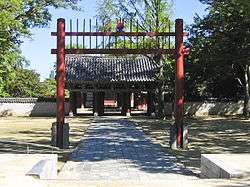Hongsalmun
| Hongsalmun | |
_of_Illeung_Royal_Tomb_(%EC%9D%B8%EB%8A%A5).jpg) The hongsalmun at the lleung Royal Tomb(Joseon Dynasty royal tombs) | |
| Korean name | |
|---|---|
| Hangul | 홍살문 |
| Hanja | 紅箭門 |
| Revised Romanization | Hongsalmun |
| McCune–Reischauer | Hongsalmun |
Hongsalmun is an architecture built as a gate for entering a sacred place in Korea.[1][2] It is arranged by 2 round poles set vertically and 2 transverse bars.[1] It has no roof and door-gate and placed on the middle top gate there is a symbol of the trisula and the taegeuk image.[1] Hongsalmun is usually erected to indicate Korean Confucian sites, such as shrines, tombs, and academies such as hyanggyo and seowon.[1]
It literally means ‘gate with red arrows’, referring to the set of pointed spikes on its top. In the past, spikes in between columns did not exist.
See also

The hongsalmun at the shrine of the clan Yi of Jeonju
References
This article is issued from Wikipedia - version of the 11/19/2016. The text is available under the Creative Commons Attribution/Share Alike but additional terms may apply for the media files.